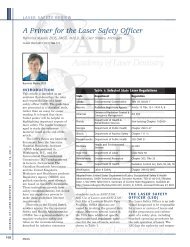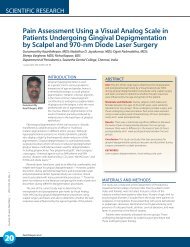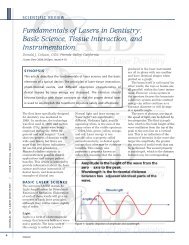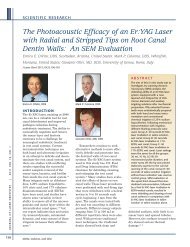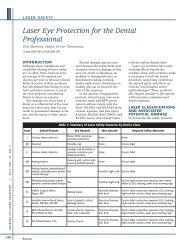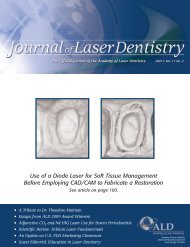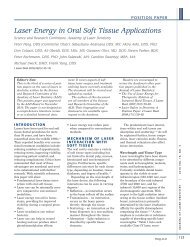You also want an ePaper? Increase the reach of your titles
YUMPU automatically turns print PDFs into web optimized ePapers that Google loves.
In their articles on the adjunctive use <strong>of</strong> lasers in<br />
implantology, Dr. Kutkut et al. (270-275) and Drs. Avi<br />
Reyhanian and Donald Coluzzi (276-281) mention the<br />
bactericidal potential <strong>of</strong> laser irradiation <strong>of</strong> implant<br />
surfaces. The notion <strong>of</strong> utilizing laser energy to reduce<br />
surface bacteria on intraoral implants as a means to<br />
help ensure successful osseointegration and reduce the<br />
incidence <strong>of</strong> periimplantitis has been studied by a<br />
number <strong>of</strong> researchers investigating a variety <strong>of</strong> wavelengths,<br />
including excimer, diode, Nd:YAG, erbium, and<br />
carbon dioxide lasers. Abstracts from a sampling <strong>of</strong><br />
published papers representing various wavelengths<br />
appear below.<br />
Most researchers to date have investigated the<br />
antimicrobial effect, primarily due to heat generated by<br />
various lasers, on implant surfaces in in vitro experiments.<br />
Heinrich and colleagues take a different<br />
approach: use a KrF excimer (248 nm) laser to promote<br />
mucosal adhesion as a biological barrier against bacterial<br />
infection. Another group (Dörtbudak et al.) studied<br />
the effects <strong>of</strong> “s<strong>of</strong>t” diode laser exposure on implants in<br />
patients.<br />
Overall, results are mixed. Certain lasers do appear to<br />
have bactericidal potential on selected microorganisms<br />
on certain types <strong>of</strong> implants under certain conditions.<br />
Questions regarding the relative efficacy <strong>of</strong> laser vs.<br />
conventional treatment remain, as do concerns related to<br />
potential alteration <strong>of</strong> implant surface morphology,<br />
thermal damage to adjacent tissues, and inability to<br />
reestablish the biocompatibility <strong>of</strong> contaminated surfaces.<br />
Nevertheless, the potential for laser application in<br />
promoting long-term implant success via bacterial reduction<br />
exists. Further study is warranted, especially to<br />
determine effectiveness and safety in a clinical environment,<br />
with special emphasis placed on appropriate<br />
parameter settings and duration <strong>of</strong> laser exposure.<br />
R E S E A R C H A B S T R A C T S<br />
Editor’s Note: The following material is excerpted and expanded from the Research Abstracts <strong>of</strong><br />
the J <strong>Laser</strong> Dent 2007;15(3):156-160. These nine abstracts are <strong>of</strong>fered as topics <strong>of</strong> current interest.<br />
Readers are invited to submit to the editor inquiries concerning laser-related scientific topics<br />
for possible inclusion in future issues. We’ll scan the literature and present relevant abstracts.<br />
L A S E R B A C T E R I C I DA L E F F E C T S O N<br />
I N T R A O R A L I M P L A N T S : A N U P DAT E<br />
In order to more closely approximate a clinical situation<br />
in their in vitro investigation, Hauser-Gerspach<br />
and colleagues examined the microbicidal effect <strong>of</strong> 810nm<br />
diode and CO 2 lasers on selected bacterial species<br />
(Streptococcus sanguinis and Porphyromonas gingivalis)<br />
adhering to dental implant materials and in<br />
suspension (planktonic cells), “because a fraction <strong>of</strong><br />
peri-implant bacteria are present as floating cells.”<br />
They point out that a key to success is adequately<br />
controlling the laser energy density and dose, factors<br />
that vary with the manual guidance and experience <strong>of</strong><br />
the operator; that is, having sufficient laser energy<br />
present to promote a bactericidal effect without leading<br />
to undesirable alterations <strong>of</strong> the implant surface can be<br />
difficult to achieve, depending upon the laser wavelength<br />
and how it is used. Even when significant<br />
reductions in bacterial counts are realized through<br />
laser irradiation, they conclude that “the question<br />
remains unanswered whether a short-term drastic<br />
reduction <strong>of</strong> P. gingivalis in the peri-implant pocket<br />
achieved by low laser energy is sufficient for stable<br />
clinical improvements. … In periodontitis therapy, a<br />
statistically significant reduction <strong>of</strong> periodontopathogenic<br />
bacteria does not guarantee clinical success<br />
because reinfection from other oral sites may occur or<br />
bacteria may survive intracellularly at the treated<br />
site.”<br />
For U.S. readers, no laser has been cleared by the<br />
U.S. Food and Drug Administration for “decontaminating”<br />
or inducing bactericidal effects on intraoral<br />
implants.<br />
As always, clinicians are advised to review the<br />
specific indications for use <strong>of</strong> their lasers and to review<br />
their operator manuals for guidance on operating<br />
parameters before attempting similar techniques on<br />
their patients. nn<br />
J O U R N A L O F L A S E R D E N T I S T R Y | 2 011 V O L . 19 , N O . 3<br />
303





